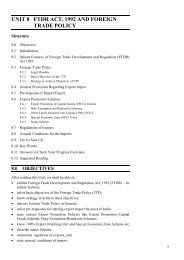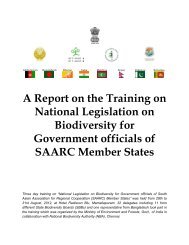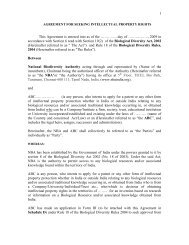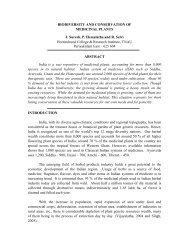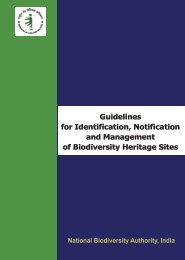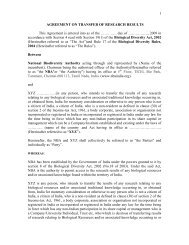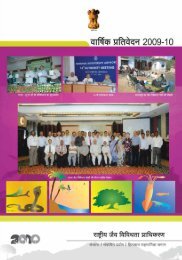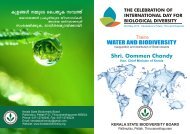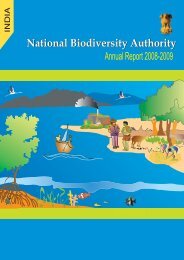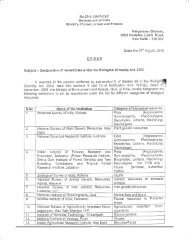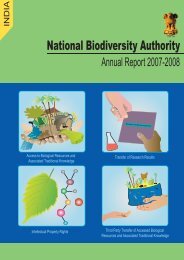BCIL BOOK.pmd - National Biodiversity Authority
BCIL BOOK.pmd - National Biodiversity Authority
BCIL BOOK.pmd - National Biodiversity Authority
You also want an ePaper? Increase the reach of your titles
YUMPU automatically turns print PDFs into web optimized ePapers that Google loves.
NATIONAL BIODIVERSITY ACTION PLAN<br />
Box 3 : Genetic Use Restriction Technologies<br />
GURT, also called terminator technology, is a biotech-based strategy that prevents seeds from germinating in the next<br />
growing season unless treated chemically by the seed company prior to planting. When seeds of crop varieties (containing this<br />
kind of genetic manipulation) are purchased from the company and planted, they germinate and grow normally but produce<br />
seeds that do not germinate when saved by the farmers for sowing during the following season. Thus, healthy and high yielding<br />
plants are genetically commanded to produce ‘sterile’ seeds preventing the farmers to use them for the next season’s planting.<br />
The technology was first developed by the Delta & Pine Land, a multinational seed company, and the US Department of<br />
Agriculture. If commercialized, ‘terminator’ would compel farmers to purchase fresh seeds from the company every year. It is<br />
bad for agricultural biodiversity and worse for the small and marginal farmers.<br />
Farmers have to purchase seeds of high yielding hybrid varieties because seeds produced by the hybrid plants are not uniform<br />
and their production capacity decreases in successive seasons. Hybrid varieties are not yet popular in self-fertilised crop plants<br />
like wheat and rice whose seeds are normally replaced after five years or so and that too on exchange among the farmers.<br />
Multinational seed companies intend to prevent this traditional practice through GURTs.<br />
It is noteworthy that India opted to enact its sui generis system (PPVFR Act 2001) for protection of crop varieties as required<br />
under the WTO-TRIPS provisions. The Indian system is largely compliant to an accepted international system for variety<br />
protection, called UPOV 1978, that permits farmers to use saved-seeds and also exempts researchers in using seeds of protected<br />
varieties. These two exemptions distinguish this system from its more recent version called UPOV 1991 which does not permit<br />
them and operates more like the patenting system. GURTs can be employed to achieve this objective without the need to seek<br />
protection or patenting of new seed varieties.<br />
The International Agricultural Research Centre, operating under CGIAR, decided in 2000 against the use of this technology<br />
and India was the first country to block its entry. The Government of India has further strengthened this action through<br />
Protection of Plant Varieties and Farmers’ Rights Act, 2001. Its section 29 (3) states that “Notwithstanding anything contained<br />
in sub-section (2) and sub-sections (1) and (3) of section 15, no variety of any genus or species which involves ‘any technology’<br />
injurious to the life or health of human beings, animals or plants shall be registered under this Act. For the purposes of this subsection,<br />
the expression “any technology” includes genetic use restriction technology and terminator technology.”<br />
which could provide much needed financial support<br />
for biodiversity conservation programmes. However,<br />
feasibility and the eventual usefulness of these controls<br />
and fiscal instruments deserve evaluation.<br />
3.9 Policy, legal and administrative measures<br />
Although a number of policy, legal and<br />
administrative measures are in place to address various<br />
aspects of biodiversity conservation [including Wildlife<br />
(Protection) Act, 1972, Forest (Conservation) Act,<br />
1980, Biological Diversity Act, 2002, etc.], there is need<br />
to promote greater harmony and synergy in these<br />
measures. Another major identified gap is lack of<br />
effective enforcement of existing laws. For tribal<br />
dominated areas, the implementation of existing laws<br />
is to be gauged in the light of sixth schedule of the<br />
Constitution.<br />
Further, role of macro-economic policies and<br />
measures on biodiversity is least understood. Policies,<br />
which directly or indirectly work as incentives for<br />
indiscriminate use of biodiversity, are insensitive to<br />
biodiversity concerns. On the other hand, biodiversity<br />
and wildlife conservation policies that rely on denying<br />
people access to their natural resource base can inflict<br />
hardships on the poor, as there is no accounting of<br />
the costs of conservation thrust on them for the<br />
benefit of distant interest groups. There is a need to<br />
promote people’s participation and, solicit their<br />
cooperation, particularly of those living inside the<br />
Protected Areas (PAs) and fringe areas.<br />
Some of the good practice initiatives taken by the<br />
Ministry of Environment and Forests include<br />
18



